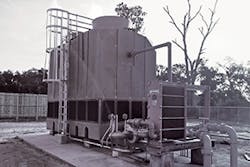WHILE HOUSTON, TX, GETS more than its fair share of rain these days, Montgomery County—approximately 40 miles to the north—is growing increasingly dependent on groundwater taken via deep wells to meet the needs of the area’s growing population.
Cities such as Conroe, Shenandoah, Oak Ridge North, Willis, and several others in Montgomery County are finding it difficult to keep up with the increasing demand for potable water resulting from a population that is growing at a rate of about 10% annually.
Although a portion of the surface water at the nearest lake, Lake Conroe, will contribute to the county’s total supply, water pumped from deep wells continues to be an important component of meeting the growing demand.
Among the drawbacks to using groundwater have been the high temperature and undesirable concentrations of two gaseous contaminants present in the water drawn from many wells—radon and hydrogen sulfide (H2S).
Water temperatures reaching 110°F are considered too hot for both residents and commercial customers; 90°F or lower is much better.
Hydrogen sulfide, which occurs naturally in a gaseous form in water taken from deep wells, is not considered a health hazard. However, in higher concentrations, which have occurred in wells located in Montgomery County, the “rotten eggs” odor of hydrogen sulfide can cause tearing of the eyes, a sore throat, coughing, nausea, and fluid in the lungs.
Radon is a naturally occurring form of radiation that, like hydrogen sulfide, occurs in a gaseous state in water. It is generally considered to be non-toxic in levels that occur in surface waters such as lakes and rivers. Yet, radon concentrations can be much higher in water drawn from deep wells. The American Cancer Society feels that when it breaks down in air, the resulting polonium and lead-214 elements can possibly damage human DNA.
After learning that the concentrations of both hydrogen sulfide and radon can be greatly reduced by “stripping” them from well water, officials at the municipal utility district in Montgomery County wanted to learn which technology was best suited to accomplish a significant reduction.
Air strippers, pumping systems that remove gasses and volatile organic compounds through aeration, are commonly used for purification of groundwater.
“Air stripping was a viable solution for drastically reducing the hydrogen sulfide and radon in the Montgomery County wells,” says Carl Pendola, president of Penco Equipment, a factory representative of manufacturers of cooling towers, air-cooled water chillers, industrial mixers, and heat exchangers. “However, using cooling tower technology would accomplish both of the county’s objectives—greatly reducing the unwanted gases while also lowering the temperature of the hot groundwater by approximately 20 degrees,” he adds.
A cooling tower is used to expel unwanted heat from water into the atmosphere by pumping the heated water to the top of the tower, then spraying the water into droplets that are exposed to the cooling, ambient air. They are most often used to provide cooled water for air conditioning, chemical processing, and other industrial applications.
The initial project for which Penco supplied the cooling tower was for Montgomery County’s municipal utility district in 2014, for a well that required only cooling.
“We were able to reduce the groundwater temperature from 110 degrees to 85 degrees with throughput of 600 gallons per minute,” says Pendola.
The cooling tower Pendola provided was a factory-assembled Delta TM Series system featuring a double-wall, seamless shell and a sump composed of high-density polyethylene (HDPE) with adjustable pitch fan blades and a totally enclosed cooling tower direct drive motor.
Soon afterward, the municipal district wanted to install a system at another well that would reduce the heat and the concentration of radon.
“I did the calculations for the radon reduction and had the Delta Cooling engineering department confirm them, and it was apparent that the cooling tower could cool the groundwater and reduce the radon concentrations by 90 percent,” explains Pendola.
The next two Montgomery County projects required the reduction of radon and hydrogen sulfide from the groundwater, as well as the cooling effect. “Because we had already performed the radon calculations and knew that hydrogen sulfide has a greater affinity to air removal than radon, we were sure we could get a 90%-plus reduction in the hydrogen sulfide,” says Pendola.
Pendola adds that the HDPE cooling towers were a good choice for the four Montgomery County groundwater extraction installations for several reasons.
“The cooling tower systems will operate for many years with minimal maintenance, mainly because of its engineered plastic HDPE shell,” explains Pendola. “This technology was developed by Delta, and the standard warranty is 20 years, versus the traditional metal-clad cooling tower, which requires much more maintenance, and typically has a warranty of only one year.”
Another important factor was water quality certification. The agency responsible for certification of water quality in Texas, the Texas Commission on Environmental Quality (TCEQ), requires that the cooling tower intake and exhaust for this application have engineered mesh screens to prevent contaminants such as insects and debris.
There was another TCEQ requirement that the top of the tower also had to be protected by mesh screening, in case the fans should be turned off. Because the fans normally thrust in an upward manner, they had to be directional in design so that they could be discharged sideways.
“The design of both the louvered panels and the protective mesh screening were provided by the Delta Cooling Towers factory as part of the complete package,” says Pendola.
Pendola concludes that this process, now proven and in place, will benefit hundreds of municipalities throughout the world sitting on top of previously untapped resources.
